
Article contents

To put cryptocurrency as simply as possible, it’s a new technology that stores transactions permanently on a database (blockchain), which can be used by anyone across the world. This removes the need to trust a company to make transactions (such as a bank), making things simpler, more efficient and cheaper. It has the potential to improve many industries.
Heard of this new thing called cryptocurrency? Not sure what cryptocurrency is? You’re in the right place. Let’s run through everything you need to know in an easy to understand way.
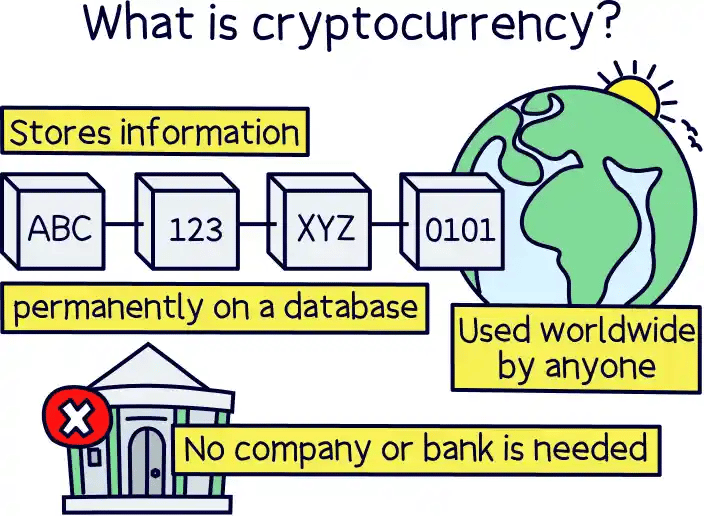
Cryptocurrencies can be thought of as digital currencies (such as Pounds and Dollars), but they're different in a fair few ways, even the name cryptocurrency is quite misleading…
They’re actually digital tokens, or coins, associated with projects or applications that are built on top of blockchain technology. A better description might be crypto assets (or digital assets). If this is even more confusing, we'll explain everything below.
If you’re here just for a quick understanding, simply think of them as online coins (tokens) that are associated with a company or project in the crypto space that can be tradeable (bought, sold and swapped) rather than an actual currency like Pounds that you can use to pay for things (although some are simple currencies to buy things with).
To first understand what that all means, let’s start from the beginning, with Bitcoin (and later Ethereum).
Bitcoin is where it all started, it was the first cryptocurrency, and you might say still the only actual digital currency (in terms of buying things with it). It was created by a person known as ‘Satoshi Nakamoto’ (or more likely a team of people), and launched back in 2008 (around the same time as the financial crash). They were motivated by creating a form of money that couldn’t be manipulated and mismanaged by governments and central banks.
Governments and central banks print vast amounts of new money which increases inflation (the price of things increasing, like milk, food and energy) and as result reduces the value of your money over time – and by quite a lot. In 2008, the government also bailed out large banks who were themselves mismanaging money.
Anyway, Bitcoin came to be and delivered a breakthrough in technology that was previously thought impossible (we won’t cover that now, but it’s to do with security of digital money, making spending the same money twice impossible, called ‘double spending’). This technology is called blockchain, which we’ll cover later.
You can understand Bitcoin with 3 key factors:
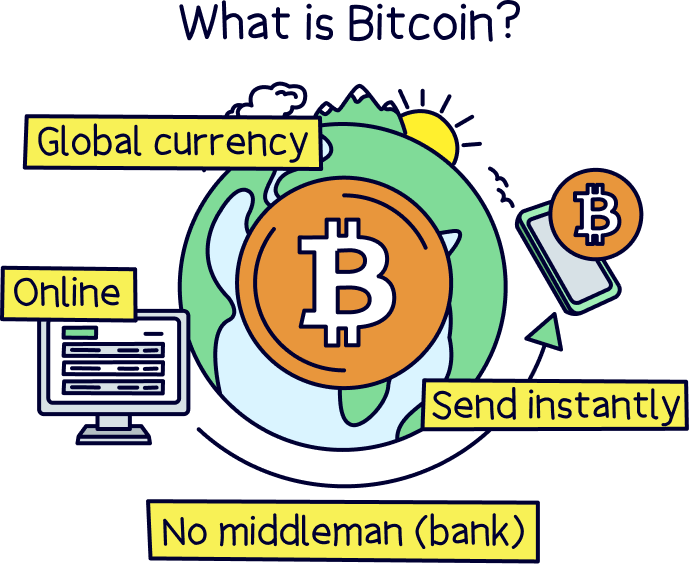
None of these key factors existed before. We just use local currencies (also called fiat currencies) and then transfer money from one currency to another when we went abroad.
Bitcoin revolutionises money, it’s the first global currency, and aims to significantly improve fiat currency.
Because there’s no central authority, like a government, it can never be mismanaged, it is effectively owned by no-one, and used by anyone who wants to use it across the world.
And because there’s a fixed supply (21 million), there is effectively no inflation, and cannot be mismanaged by printing more bitcoin. Therefore, the value of your money remains consistent. Because of this, in the future it could also be seen as a ‘store-of-value’, similar to gold.
As it’s peer-to-peer, it means you can send bitcoin directly to another person, or to a shop when buying something, without the need for a bank or payments company (like VISA), and for very low cost (often free when buying something). And it’s very fast, and works all across the world.
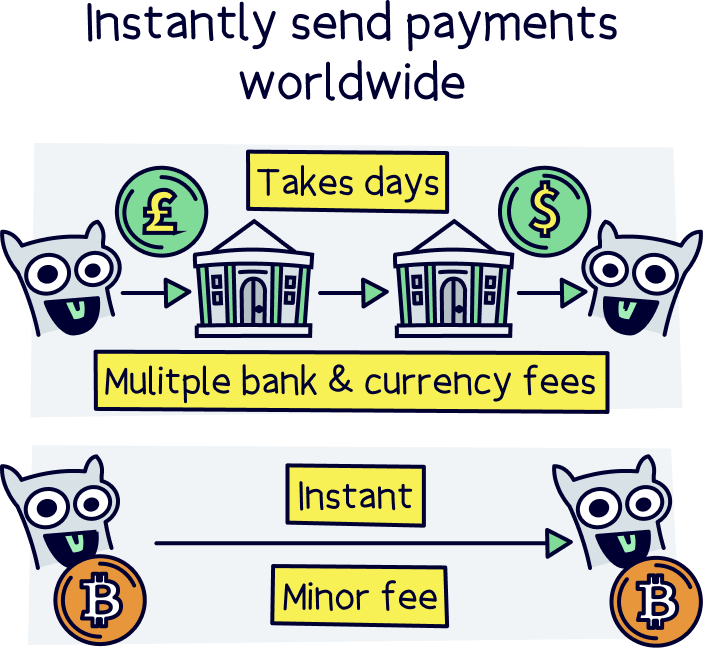
With traditional currencies, payments go through your bank (a central authority), and several other banks and financial companies before ending up in the receiver's bank account. And if it’s international, it’s very expensive – plus hidden fees such as currency conversion fees, and it’s not instant, it can actually take days, and sometimes even weeks.
Ethereum builds on Bitcoin’s technological innovation, the blockchain, but instead of being intended as a digital currency, it’s designed to have computer programs run on it. You could think of it as similar to your mobile phone, which has lots of different apps (applications) on it, all doing different things – but they use the same underlying technology, the phone and the operating system.
That’s what Ethereum is. It’s the operating system for others to build their own apps on (called decentralised apps, or dapps), with all the benefits of blockchain technology – which is always running, no central authority required, like a bank of company (so no trust required) and transactions are peer-to-peer, quick, and low-cost.
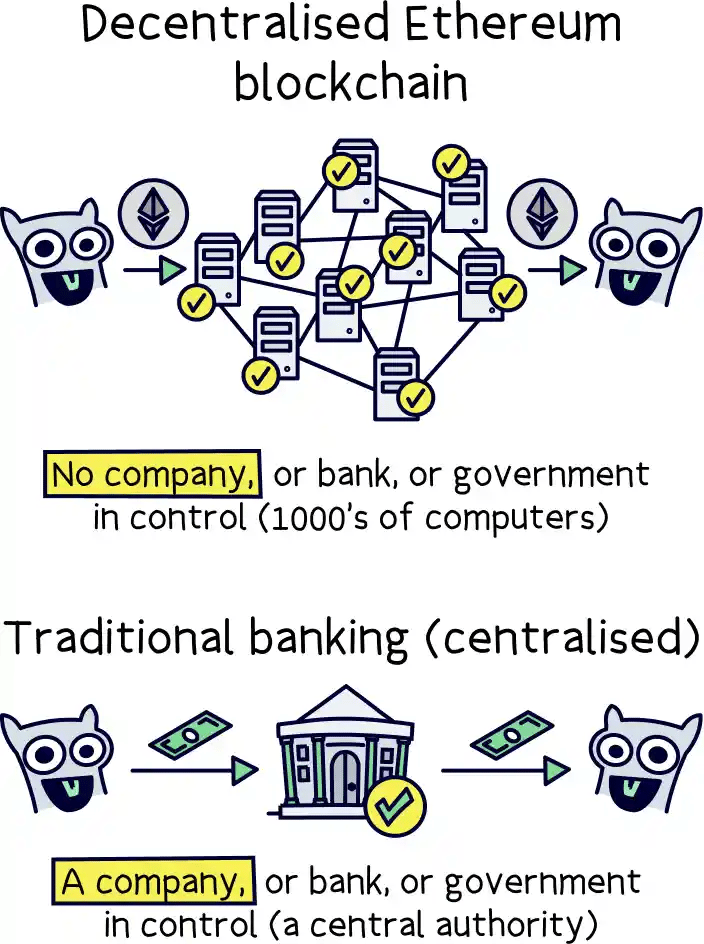
It’s quite revolutionary, perhaps even more so than Bitcoin. It has the potential to make existing ways of doing things vastly better, more transparent and without the need to trust a company (and therefore removes things like fraud and corruption, among other things).
For instance, lots of finance involves trusting other people and companies. Ethereum has eliminated this need and a whole industry, decentralised finance (DeFi), has been created.
Imagine you have an insurance policy, currently you’ll have a paper contract that will specify what is and isn’t covered and all the rules, but in reality it’s up to the insurance company to decide if and how much they’ll pay out.
With DeFi, the contract is within the application itself, there is no human on the other end to decide if you’re entitled to a payout. If you meet the rules for a payout, you’ll automatically get one. It is effectively written into the code of the application, and once live, cannot be changed or deleted, a deal is a deal!
These online contracts are called ‘smart contracts’ and are the core of Ethereum technology. They’re not limited to DeFi, any and every industry will probably be significantly improved in future. That’s why Ethereum is so exciting.
In order for smart contracts and apps to run on Ethereum, they need to use Ethereum’s own cryptocurrency, or a better word is called a token, which is called ‘ether’. When you buy ethereum, you are actually buying ether, although they’re often used interchangeably. And you’ll pay a small fee, called a gas fee, every time you want to make a transaction on the Ethereum blockchain (applications will make transactions as part of how they run, for instance, creating the insurance policy in our example).
Now that you know a bit about Ethereum, you can understand all the other cryptocurrencies a bit more. Ethereum established the network (blockchain) that allowed anyone to create their own applications (decentralised applications), and therefore the tokens to go with it. These tokens are called ERC-20 tokens, and can represent anything to do with the application.
They are often used to raise funds for projects to be built (for instance to pay software engineers), very similar to how a start-up company would raise money from investors and venture capital firms, by selling part of their company for investment. In fact, in the future it’s likely every company would raise money this way. Although for now it’s still very early.
Other tokens can have ‘utility’, and provide the user of an app with something, or be required to use an app. For instance, lots of games that operate on a blockchain require the token to do things, or buy things within the game.
Once a token has been created, it can be freely traded to others (bought and sold), and therefore there's money to be made. And it’s this trading that has captured a lot of the headlines and interest, rather than the utility behind a token.
The tokens can be sent directly to someone else's address (wallet) on a blockchain, or, they can be traded on cryptocurrency exchanges. These exchanges can either be an application on the blockchain itself, called a decentralised exchange (DEX), or, an exchange run by a company in the traditional sense, called a centralised exchange (CEX).
Cryptocurrencies can be created on various blockchains, which we’ll cover in more detail below. They don’t all have to be created on Ethereum (the most popular blockchain). Other blockchains include Avalanche and Solana.
You can learn more about crypto exchanges with our best crypto exchanges (UK).
We’ve mentioned blockchain technology a few times but let’s explain it in a bit more detail. A blockchain is the foundation of crypto technology. It works similar to a database, which is a computer system that stores information (data). And with a blockchain, this information is contained in transactions.
These transactions, which can be tokens sent to another address on the blockchain, or data stored within the transaction itself, are stored permanently on the blockchain, stored at the time the transaction was made, and can never be changed in the future.
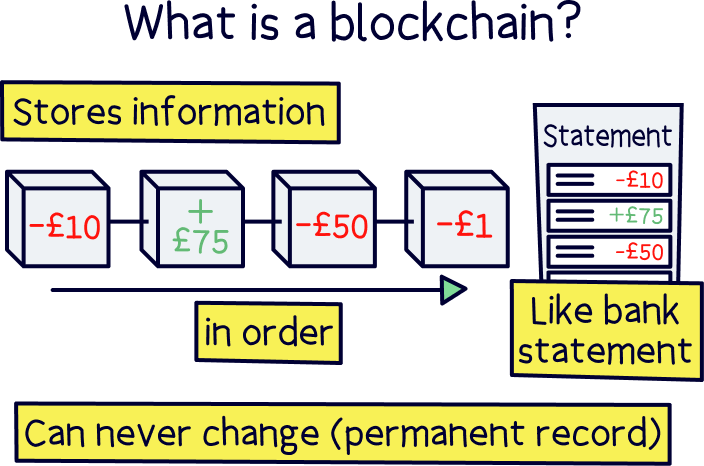
It’s very advanced technology, and as it runs essentially by itself, it can never be stopped, and everyone has access to make transactions or read previous transactions – it is a global and public network. (Transactions can still be anonymous.)
As transactions are permanent, cannot be changed, and read by the public (or in reality, other software), it means things like currencies (like bitcoin), can be built on top of it.
The blockchain gives the currency a fully permanent record of financial transactions (such as sending money to a friend) – removing the need for a bank, government or central authority to make transactions for you, or even store your money. (Your money can still remain private.)
Put simply, there is no need to trust a company with your data (money), which removes any potential for errors, fraud and corruption.
This trustless way of operating can be used for many industries, for instance, supply chain management (sending goods across the world) and scientific research. Although currently, the ability to improve financial services is getting a lot of interest – spawning a new industry called decentralised finance.
A blockchain works with many transactions happening every second, and these transactions are grouped together into a ‘block’ which covers a set period of time, for instance, with Bitcoin, this is every 10 minutes.
After every 10 minutes, the transactions in the block are fully confirmed and the block is added to all the previous blocks, making all transactions permanent. And that’s how the name blockchain came about (an ever growing chain of blocks).
To confirm the transactions and add the new block to the blockchain, lots of computers are running the blockchain software across the world, and these are called nodes. (With Bitcoin, this process is called mining, and the nodes are Bitcoin miners.)
These thousands of nodes are all connected and verify all transactions are legitimate, and all have consistent records of transactions, making it impossible to be hacked or previous records changed. This is the decentralisation aspect of public blockchains – it’s not possible to alter or stop.
A crypto wallet (or digital wallet) is like your very own bank account on a blockchain, it stores your cryptocurrencies nice and safely until you want to use them. No one else can access your account, only you.
They work by creating a public address on the blockchain, which is associated with transactions. So, if you make a transaction sending a certain amount of bitcoin for instance, this transaction will show that your address has reduced by a certain amount, and your friends address has increased by a certain amount. And this is actually how blockchain technology got the name digital ledger (or distributed ledger).
Your wallet, or address, can only be accessed and recovered with a private key (also called a seed phrase), which is created when you first make your wallet. This makes it super secure, but you need to make sure you look after it, and never share it – to make sure only you can access your cryptocurrency.
Wallets exist on every blockchain, but they are different wallets. So you can have your own Bitcoin wallet, and your own Ethereum wallet – but you can’t send transactions from one network to another (send ether to the Bitcoin network).
To find the best wallet for you, here’s where to find a Bitcoin wallet, and Ethereum wallets. With Ethereum, MetaMask is also very popular.
Now you’re probably reading this because you want to buy some crypto, or learn about it a bit more before you invest. So, let’s run through how to buy other crypto too. Don’t worry, it’s easy when you know how!
Bitcoin is the most popular cryptocurrency by far – it’s super popular, and it’s super easy to buy.
All you need to do is use a crypto exchange. Think of it as a middleman between buyers and sellers of cryptocurrencies. (Similar to a stock broker, if you’ve ever purchased shares before.)
With crypto, you simply head over to a crypto exchange, deposit some money, select bitcoin and buy. The exchange will take care of everything and you’ll have some bitcoin in your account.
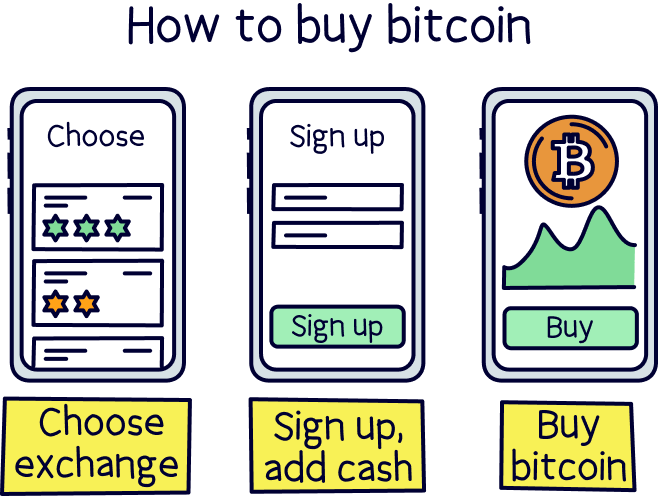
It’s then up to you whether you want to keep your bitcoin in your account with the exchange, or send it to your own bitcoin wallet for safekeeping or to make transactions.
If you’re still a bit unsure, check out our guide on how to buy bitcoin (UK), which has more detail.
If you’re ready to buy, check out the best crypto exchanges in the UK.
eToro is easy to use and super popular. Great for beginners to advanced traders.



CoinJar is a great option to get started with crypto (and for those more advanced).
It’s very well established (since 2013), and has over 600,000 customers worldwide – and one of the best rated for customer support (Trustpilot).
It’s user-friendly, and the mobile app is great.
You can deposit and withdraw Pounds (GBP) quickly and seamlessly too – and buy and sell very quickly, either in a few taps, or set pending orders on their advanced exchange for regular trading (and low fees).

Note: customers in the UK are required (in accordance with local legislation) to complete an appropriateness assessment to show they understand the risks associated with what crypto/investment they are about to buy and enabling CoinJar to categorise them as an investor. New customers are also required under local regulations to wait 24-hours as a “cooling off” period (from account creation), before their account is active (i.e. to deposit, trade, withdraw etc.).
CoinJar is FCA registered, meaning it’s allowed to verify identities and provide crypto and local currency transactions.
Nuts About Money rating: 5 stars
Fees: low
Minimum deposit: £10
eToro is easy to use and super popular. Great for beginners to advanced traders.
If you want to buy ethereum, the process is very similar, simply head to a crypto exchange, deposit money, and then buy ethereum (ether).
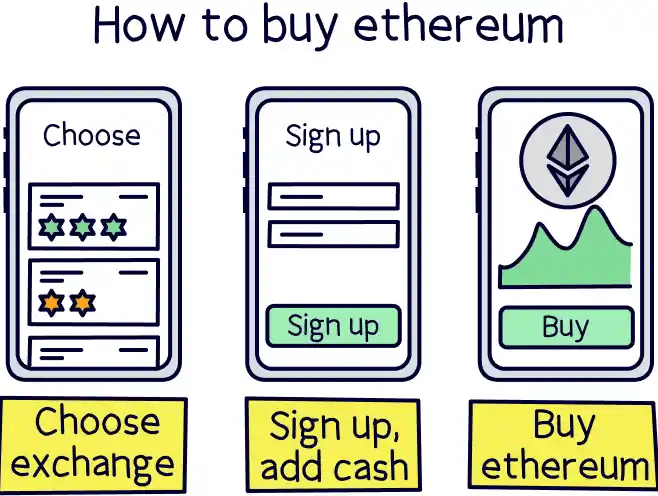
You can then send your ether (Ethereum) to your ethereum wallet (remember, it’s a different wallet to Bitcoin).
Here’s the best crypto exchanges to get started, or if you’re looking for more detail, here’s how to buy ethereum in the UK.
And if you’re looking to buy other cryptocurrencies, it depends on which crypto you’re after as to where to buy. But, most of the major cryptocurrencies are on the larger crypto exchanges (for instance Bitcoin and Ethereum).
If you are looking for a newer coin, or one that’s a bit smaller, and not too popular, you might have to use a decentralised exchange – this is an exchange that runs on the blockchain itself.
For Ethereum, the most popular decentralised exchange is Uniswap. Although you’ll need an Ethereum wallet first – and some ether to make transactions. So start with a centralised crypto exchange first.
And that’s it! We hope this helped you understand cryptocurrencies a bit more. If you’re looking for more information, the Ethereum website and Bitcoin website are great places to learn more.
And if you’re looking to start trading in the cryptocurrency market (buy and sell cryptocurrencies), check out our best crypto exchanges, good luck!
Digital currencies are super exciting, and there’s a lot of great projects out there – just be sensible and do your research first!
eToro is easy to use and super popular. Great for beginners to advanced traders.
eToro is easy to use and super popular. Great for beginners to advanced traders.
We’d love to hear from you, and it will help others too.
eToro is easy to use and super popular. Great for beginners to advanced traders.